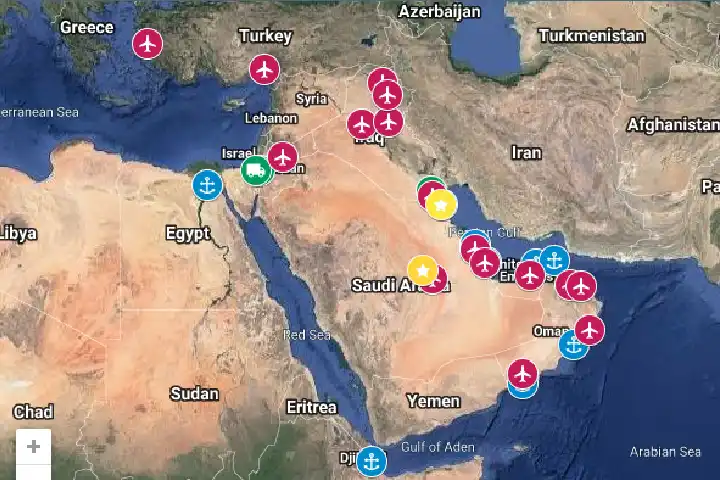
US maintains battle-ready military, navy, air force bases in almost all key countries of the region.
Around 13 attacks have targeted US and allied forces’ bases in Iraq and Syria in the past one week. All attacks, the Pentagon confirms, have taken place with drones and rockets. The reports of exact damage, however, are not available.
“Between October 17th and the 24th, US and coalition forces have been attacked at least 10 separate times in Iraq and three separate times in Syria,” Pentagon spokesman Brigadier General Pat Ryder said.
The attacks were conducted with a “mix of one-way attack drones and rockets,” Ryder told journalists, describing the tally of the strikes as “initial numbers.” Two dozen American military personnel have been wounded in a series of drone attacks at American bases in Iraq and Syria, US Central Command has told NBC News.
Islamic Resistance of Iraq released a video showing its attack on Al Harir air Base in Northern Iraq.
Same like in the attack on Ain Al Assad base carried out by Al Warithin, the Ababil-T/ Qasef-1 Suicide drone were used#Iraq #USA #العراق pic.twitter.com/3ev5TO8zXJ— Bedou_int (@bedou_int) October 19, 2023
He did not identify the specific organisations responsible, but said that “the groups conducting these attacks are supported by the Iran Revolutionary Guards’ Corps (IRGC).
According to Arabic and Persian media reports, a group calling itself the “Islamic Resistance in Iraq” in Telegram channels affiliated with Shia factions close to Iran, has claimed responsibility for attacks in Iraq.
Besides the US Navy warship USS Carney in the Red Sea shot down three cruise missiles and several drones on October 19 that were launched by Iranian-backed Houthi rebels. The destroyer was heading toward Israel, the Pentagon said.
All these attacks on foreign military bases have taken place within the period when the Iranian government threatened retaliation if “Gaza Genocide” by Israeli forces is not stopped immediately.
The US has some 900 troops in Syria and 2,500 in Iraq as part of efforts to combat ISIS, which once held significant territory in both countries but was pushed back by local forces supported by international air strikes.
Reports emerge of kamikaze UAV attacks on American Al-Harir & Ain al-Assad air bases in Iraq. Tensions in the Middle East are on the rise. 🚨 #MiddleEast #Conflict pic.twitter.com/OsyiWqVH7P
— Anil Tiwari (@Anil_Kumar_ti) October 18, 2023
Experts believe that the Israeli ground invasion in Gaza will determine the degree of escalation that it is likely that Iran and its proxies will go berserk then.
“How far the Islamic Republic goes in mobilising its client militias will be dictated by the success or failure of the IDF ground operations in Gaza — though escalation could result either way. If the Israeli operations go well, Iran could seek to broaden the conflict. If they go badly, it may look to exploit perceived weakness. It is also possible that the leaders in Tehran choose instead to limit the conflict, preserving their proxies’ capabilities to deter Israel from attacking Iran itself,” said David Schenker, former Assistant Secretary of State for Near Eastern Affairs and a Senior Fellow at The Washington Institute.
Schenker’s estimate was met with a warning from the Iranian Defence Minister on Tuesday. “The enemies know that should they make any mistake (going for ground invasion in Gaza), they will be met with the Islamic Republic of Iran’s strong and decisive response,” said Brigadier General Mohammad-Reza Ashtiani.
A Look At US Security Bases In MENA Region
The United States maintains sophisticated battle-ready bases – Military, Air Force and Navy – in a number of countries in the Middle East and North Africa region.
Bahrain:
The US operates in Bahrain by means of a Defense Cooperation Agreement signed in 1991,1 and a Status of Forces Agreement originally signed in 1971.2 There are over 7,000 US military personnel based in Bahrain — the US 5th fleet. It patrols an area of responsibility covering the Arabian Gulf, the Gulf of Oman, the Red Sea, and the Arabian Sea, including the Strait of Hormuz, the Suez Canal, and the Strait of Bab al Mandeb. Together US bases in Bahrain are known as: Naval Support Activity Bahrain, Shaikh Isa Air Base and Muharraq Air Base (Navy).
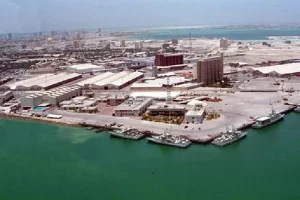
Qatar:
Qatar hosts approximately 10,000 US service personnel, mostly at Al Udeid Air Base, which is the biggest US base in the Middle East. In 2003 following the invasion of Iraq, the US has withdrawn sufficient size of its troops from Saudi Arabia and deployed them in Qatar. It was from the Qatari base that the US forces ran their anti-ISIS operation. Besides Al Ubeid, the US maintains an army-operated facility – Camp As Sayliyah – which serves as a warehouse of equipment and repair factory for damaged vehicles.
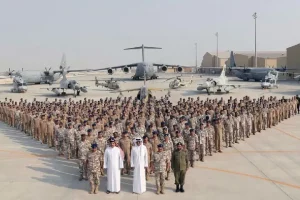
UAE:
5,000 US security personnel are stationed in the United Arab Emirates. The UAE base served as a coordinating centre for US forces while they were conducting operations in Afghanistan. Overall, three US bases are operational in the UAE along the Persian Gulf and they are known as: Al Dhafra Air Base, Port of Jebel Ali and Fujairah Naval Base.
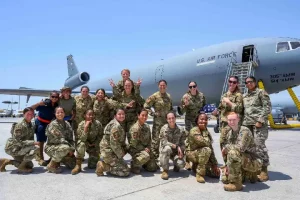
Oman:
Oman the first country among the Persian Gulf States to explicitly partner militarily with the US. The US can conduct 5,000 aircraft overflights, 600 landings, and 80 port calls annually from the Omani facilities. During the early stages of Operation Enduring Freedom in Afghanistan (in late 2001), the US relied considerably on Omani air bases. However, in the subsequent years, US presence in Oman has dwindled significantly. Overall, the US maintains six facilities in Oman: RAFO Masirah, Muscat International Airport, RAFO Thumrait, Al-Musannah Air Base, Port of Duqm and Port of Salalah.

Saudi Arabia:
The establishment of the US base in Saudi Arabia in 1991 at the time of First Gulf War has been hotly debated in the Muslim world and it has created a lot of heartburn. Consequently, the US withdrew most of them in 2003 as it invaded Iraq in Second Gulf War. The US security personnel travel and work at different Saudi bases to complete their mission, but the primary “basing” point is Eskan Village near Riyadh. The US has about 3,000 troops in Saudi Arabia and they reportedly helped repel Houthi attacks when Saudi was locked in a battle with them.
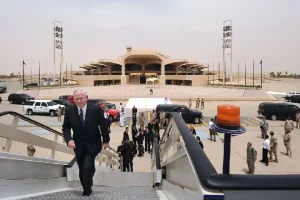
Kuwait:
Kuwait holds major non-Nato US ally status and was liberated by US and Nato forces against Iraqi invasion in 1991 and since then it has maintained facilities to house US security personnel. 2011, troops garrisoned in Kuwait are primarily intended to support Operation Spartan Shield, a mission to “deter regional aggression and stabilize countries within the region”. Overall, there are four US bases in Kuwait: Ali Al Salem Air Base, Camp Arifjan, Camp Buehring and Camp Patriot.
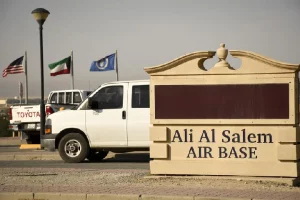
Iraq:
Since the withdrawal of US forces in 2011, the US has not maintained permanent facilities in Iraq. The primary US presence is at Al Asad Air Base in western Anbar province. Colloquially known as “Camp Cupcake” due to amenities available here during the Gulf war, it now only serves as the centre of Task Force Lion that advises, assists, and “enables” the Iraqi military.
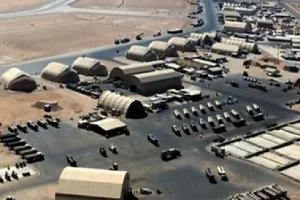
Jordan:
The US forces are located at Muwaffaq Salti Air Base in Jordan. After the emergence of ISIS, the US forces coordinated their operations from Qatar and Jordan. The US military cooperation with Jordan is close. Most recently, US troops participated in the “Eager Lion” exercises, involving several thousand US Marines training alongside Jordanian troops.
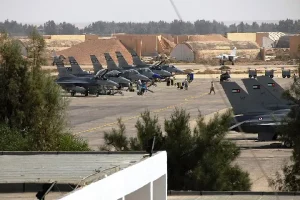
Israel:
The security assistance between Israel and the US does not require any elaboration. The US is the most devoted backer of Israel and actively assists in building the Jewish state’s military capabilities, including its fabled anti-missile Iron dome system. The US 6th fleet frequently makes port visits to Haifa. Two US bases in Israel are known as: Dimona Radar Facility and Mashabim Air Base/Bisl’a Aerial Defense School.
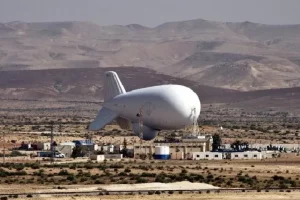
Egypt:
The US military does not maintain combat basing in Egypt, despite the historically robust military cooperation between the countries since the conclusion of the 1979 Israeli-Egyptian peace treaty. The only US military facility in Egypt conducts medical research – the Naval Medical Research Unit Three (NAMRU-3).




















